Growing Up in Scotland: Sweep 3 Food and Activity Report
This report uses data from the Growing Up in Scotland study to explore the prevalence of, and many issues related to, food and activity in Scotland specifically in relation to young children.
Chapter 4
The Relationship between Nutrition, Activity, and Body Mass Index
4.1 Food and activity
4.1.1 The relationship between food and activity
Research has shown that nutritional patterns are best understood when looked at in combination with habits of physical activity, and that exercise and diet are both essential components for children's healthy development (Reilly, 2006). Using the respective diet and activity scales (see sections 2.4 and 3.1), the relationship between diet and activity was explored to see how they are associated. Among children with a relatively poor diet, 42% were in the low activity and 22% in the high activity group (Figure 4 A). The proportions were reversed for those who have a relatively good diet, where 25% are less active and 39% are more active. Children with an average diet seem to be fairly evenly distributed in terms of activity, so it is only children with a relatively healthier diet and those with a relatively unhealthy diet who also differ very much in terms of physical activity.
Figure 4 A Diet score by activity score
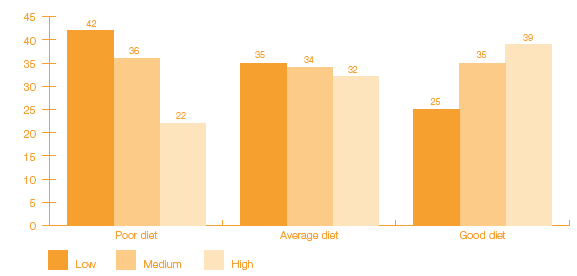
Base: All child cohort: weighted - 2332, unweighted - 2280.
It is difficult to judge whether eating fruit and vegetables promotes children to be more active or if children's levels of physical activity determine their preferences for these foods, although the data show that some form of relationship exists between activity and diet. However, this should not be taken to mean that a certain diet may cause a child to be less or more active, or that a certain level of activity may cause a child to eat certain foods. While food and activity may influence each other in a cyclical effect to some extent, it is likely that both children's diets and their activity levels are influenced by other factors, such as the child's preferences, as well as the family's preferences, the priorities of, and options available to, parents, the child's home environment and neighbourhood and more.
In order to determine to what extent diet and activity were related, two linear regression models were modeled on the two scales. The first regression aimed to evaluate the extent to which diet explains activity, and whether the association between diet and activity is significant. The results 3 indicate that while there is a statistically significant association, in fact, changes in the diet score only explained a very small proportion ( c.3%) of changes in the activity score.
The second regression 4 aimed to evaluate the extent to which activity explained diet, and whether the association between activity and diet is significant. The results are virtually identical to the first model. Although the association is again statistically significant, changes in the activity score only explained a very small proportion ( c.5%) of changes in the diet score. While diet and exercise are clearly related, other underlying factors are likely to influence both what and how children eat and the types of activities they do, such as the socio-economic differences seen in both sections 2.3.1 and 3.2, for example in relation to income, NS-SEC5 and the educational qualifications of the mother. To some extent, looking only at what children eat and at how they spend their time assumes that children develop these nutritional and lifestyle patterns in a social vacuum. Clearly this is not true, and a range of factors at a broader level beyond the child's immediate control will affect his or her nutritional habits and preference for activities.
4.1.2 The relationship between activity group and specific food types
A study of children aged 5 to 7 based in Northwest Germany found that watching TV for more than one hour per day was linked to a higher consumption of unhealthy foods and a lower consumption of fruit and vegetables (Müller et al., 1999). Looking more specifically at different foods eaten and their relationship to the child's activity level, we find that among children with a low activity score, 39% snacked on chocolate and sweets between meals, 38% on crisps and 38% snacked on cakes and biscuits, while the respective proportions for children with a high activity score were lower at 28%, 25% and 28%. However, interestingly, while less active children appear more likely to consume unhealthier foods, there was relatively little variation in the proportions of children snacking on fruit across children of all three activity levels.
Figure 4 B Snacks eaten between meals by activity level
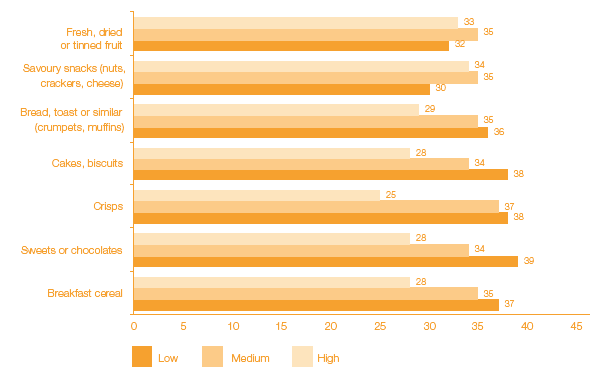
Base: All child cohort: weighted - 2332, unweighted - 2280.
However, Figure 4 C shows how less active children are less likely to eat a variety of vegetables on a typical day than their more active counterparts. Indeed, among children who did not eat vegetables on a typical day, 45% were in the low activity group compared to 22% who were in the high activity group, with the pattern essentially inversed for those who ate five or more types of vegetables. Furthermore, more active children are more likely to eat a greater range of fruit than children who are less active: 47% of children eating no fruit falling into the lowest activity group and 22% in the highest, in complete contrast to 22% of children who ate five or more types of fruit a day who were in the lowest activity group, with 50% in the highest activity group.
Figure 4 C Consumption of different vegetables by activity level
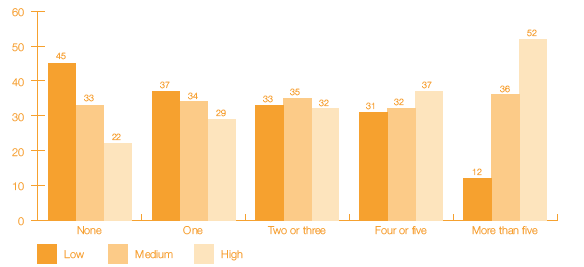
Base: All child cohort: weighted - 2332, unweighted - 2280.
As previous research on older children in Germany had indicated (Müller, 1999), GUS data shows that less active children are more likely to eat unhealthy foods more often than their more active counterparts. Forty-two percent of less active children ate sweets or chocolates once a day, and 29% ate them 2 to 3 times per week, compared with more active children, of whom 38% ate sweets daily, and 33% 2 to 3 times per week.
The pattern is similar when it comes to sugary soft drinks. There is almost a 10% difference between children in low (38%) and high (47%) activity groups when it comes to drinking soft drinks on a rare occasion. Conversely, less active children were more likely to drink soft drinks more than once a day (31%) than children in the high activity category (25%). Excessive consumption of sugar is often blamed for causing disorderly behaviour among children, and for making them hyperactive and moody. Perhaps it could have been assumed that excess sugar in a diet would at least prompt a more active lifestyle, but the data seem to suggest the opposite is true.
Furthermore, activity was found to be mildly associated with differences in the intake of salt from food such as crisps. Among children in the low and medium activity group, 24% eat crisps once a day, compared to 18% of those in the high activity category. In turn, children in the medium activity category were those most likely to eat crisps only once a week (19%).
4.1.3 Snacking and sedentary activity
Figure 4 D looks at how nutritional patterns vary among children who spend different amounts of time in sedentary activities like watching TV and playing computer/electronic games. It would be expected that children who spend a lot of time playing games on the computer or watching television are more likely to also snack during these activities on unhealthy foods. Research based on 4 to 5 year olds in England and Wales found that children who had a higher preference for energy-dense and fatty foods also had a stronger preference for sedentary activities, like watching TV and playing computer games (Wardle et al., 2001).
Figure 4 D Consumption of unhealthy snacks by time spent watching TV on weekdays
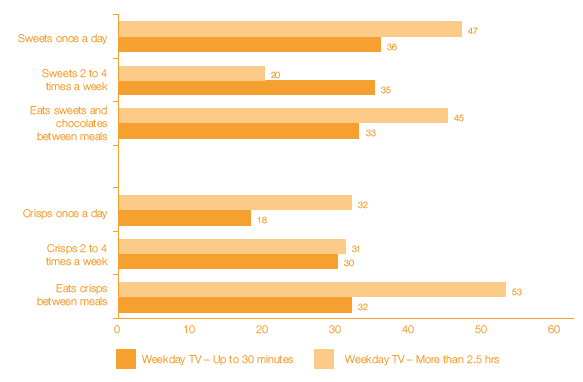
Base: All child cohort: weighted - 2332, unweighted - 2280.
The data indicates that these findings also hold true for Scottish children. Among those who watched TV for more than 2.5 hours on weekdays 53% ate crisps, and 45% ate chocolates and sweets between meals. This contrasts greatly to children who watched up to 30 minutes of TV on weekdays of whom 32% ate crisps, and 33% ate chocolates and sweets between meals. In a similar way, of those children who play computer games on each day of the week 50% eat crisps and 39% eat chocolate and sweets between meals. The corresponding figures for children who do not play computer games are 32% (crisps) and 33% (chocolate and sweets).
The figures show an association between sedentary activities and eating unhealthy foods, but they cannot show if children eat unhealthy food during the time they spend in sedentary activities, or whether these foods are eaten at a different time during the day. More specific questions looking at children's eating habits during such sedentary activities would be useful in this respect.
4.2 Body Mass Index ( BMI) - Measuring obesity
The primary reason for concern about children's diets and physical activity is the effect that these have on health, both in childhood and later life, in particular in relation to being overweight and obese. Overweight and obesity are terms that refer to an excess of body fat and they usually relate to an increased weight-for-height ratio. The two terms, however, denote different degrees of excess adiposity, and overweight can be thought of as a stage where an individual is at risk of developing obesity (Barlow and Dietz, 1998). The adverse health consequences associated with obesity are related to an increased adiposity rather than an increased weight per se (Taylor et al., 2002) and it is therefore important that any indicator of obesity reflects this increased adiposity. Body mass index ( BMI) takes into account weight and height: it is calculated as weight (kg) divided by squared height (m2) and it is the key overweight and obesity measure in this chapter. For further explanation of BMI and the use of UK and international cut-offs, please see Appendix A.
Height and weight measurements were taken of children in the child cohort at sweep 2 and therefore the analysis in this section is based on the results of measurements for children mostly aged 46 months. 6
4.3 BMI and obesity - Key points from sweep 2
As the information on the children's height and weight was collected in sweep 2, most of the important findings related to children's BMI were already reported in the GUS sweep 2 report (Bradshaw et al., 2008). The key points below summarise the main findings on BMI based on that report.
- Most children (77%) were of 'normal weight' (below the 85% percentile). By the international standards, 23% of children in GUS were overweight (including obese).
- Girls were more likely than boys to be overweight (19% compared with 16% of boys) and more likely to be obese (7% compared with 5% of boys).
- Children living in lone parent families were more likely to be overweight or obese (26%) than were children in couple families (23%). However, when looking only at girls, almost double the proportion of girls in lone parents households were obese.
- Children who were classified as white, were more likely to be overweight or obese (24%) than their non-white peers (14%).
- Children who were obese were slightly more likely to have a long-standing illness than overweight (not including obese) or normal weight children (18% of obese children compared with 15% of non-obese children).
4.4 BMI in relation to nutrition and activity
Several studies have looked at the relationship between eating, physical exercise and weight. Diets high in fibre-rich cereals, fruit, vegetables, fish, olive oil and nuts, and low in meat, processed meat foods and trans-fatty acids favour a healthier weight and reduce the likelihood of obesity (Bullo et al., 2007; Reilly et al., 2005). The relationship between sugar-sweetened drinks and weight gain has also been reported (Malik et al., 2006), but research has also linked excessive consumption of natural fruit juice to obesity (Dennison et al., 1997; Malik et al., 2006). Exercise and diet form two sides of the same coin in terms of healthy development for children (Reilly, 2006). The association between sedentary activities, like watching TV, and excess weight gain in children has been discussed in various studies (Bogaert et al., 2003; Gable & Lutz, 2000; Reilly, 2006).
With data collected through GUS in sweep 4, it will be possible to look at the relationship between nutrition, exercise and the change in children's BMI from sweep 2 to sweep 4. Currently, the data from sweep 3 can show us if children of different BMI ranges in sweep 2 have different nutritional and exercise patterns in sweep 3, but it cannot tell us the effects of these nutritional and exercise patterns on their future weight, until this has been measured in sweep 4.
Figure 4 E and Figure 4 F illustrate how normal weight, overweight and obese children as weighed and measured in sweep 2 compare in terms of their activity and diet score in sweep 3. There seems to be a very small difference in the level of activity and in the relative quality of children's diets in sweep 3, when comparing children who in sweep 2 were recorded as being of normal weight, overweight, or obese. Among obese toddlers, 9% were in the relatively good diet category, and 29% in the relatively poor diet category, while the respective figures for normal weight children are 13% and 24%. Children who were
of normal weight, overweight and obese in sweep 2 had a very similar activity score in sweep 3, and were roughly evenly spread among the low, medium and high activity category.
Figure 4 E Diet scores by BMI
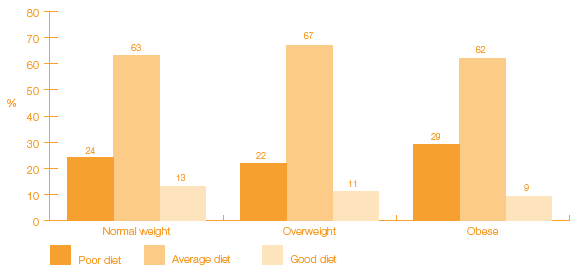
Figure 4 F Activity scores by BMI
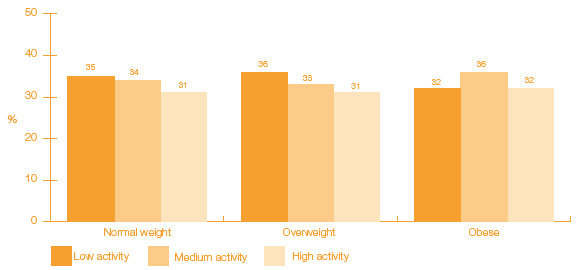
Bases: All child cohort with valid height and weight measurements: weighted - 1979, unweighted - 1987.
Linear regression 7 was undertaken to explore if there was a statistically significant association between BMI in sweep 2 and activity score in sweep 3. The results (see Appendix C for detail) show that while the relationship is significant, the BMI score of children in sweep 2 only predicted about 1% of change in their activity score the following year. This means that children's BMI as measured in sweep 2 was not a very important factor in explaining the differences in activity levels in sweep 3. It will be interesting to see, however, if children's levels of physical activity in sweep 3 help to predict the BMI of children in sweep 4.
A second regression model aimed to see if there was a statistically significant association between BMI in sweep 2 and children's diet score in sweep 3. The results show that while the relationship was significant, the BMI score of children in sweep 2 only predicted about 1% of change in their diet score for sweep 3. This means that children's BMI as measured in sweep 2 was not a very important factor in explaining the differences in diet in sweep 3. Once again, only after the 4th sweep of data has been collected will it be possible to explore if children's diets in sweep 3 help to predict their BMI in sweep 4.
4.5 Observing change in BMI - sweep 4
It would appear that contrary to established evidence, children of different weight-ranges have very similar nutritional and exercise habits. This, however, would be a premature conclusion. It is important to remember that children's BMI is based on their weight and height at the second sweep of GUS, when the children were just approximately 3 years and 10 months old. This is still a critical age in development and the pace at which different children develop and grow varies greatly. Furthermore, the information on children's activity and diet is based on sweep 3 when the toddlers were approximately 4 years and 10 months old, and comes one year after the children's BMI was measured. We can therefore not be sure if children's nutrition and exercise patterns in sweep 3 are similar to those they had in sweep 2 when they were weighed, and we can also not know if children's BMI in sweep 2 will have remained the same through sweep 3.
Finally, research has shown that different nutritional patterns among infants and young children may take some time to manifest themselves in the form of excess weight or obesity in later childhood. A study by Ong et al., (2000) based on the Avon Longitudinal Study of Pregnancy and Childhood ( ASLPAC) found that 'catch-up growth', known as the process by which low or under-weight babies grow very rapidly during infancy and early childhood, was associated with higher BMI scores at age 5. This means that many babies, who were found to be underweight at birth and in infancy, grew very rapidly during their first five years of life so as to result as obese or overweight by the age of 5. Therefore, with respect to the GUS cohort of children, it is not necessarily the case that differences in BMI associated to diet and exercise would become immediately apparent. As the children were only 3 years and 10 months of age at the time of measurement, some changes in weight may take a longer time to emerge. It will be interesting to see how the children's diets and physical activity in sweep 3, when they were aged 4 years and 10 months, will relate to their weight in sweep 4, when they are aged 5 years and 10 months, when the physical outcomes of different diets and activity patterns may be more evident.
There is a problem
Thanks for your feedback